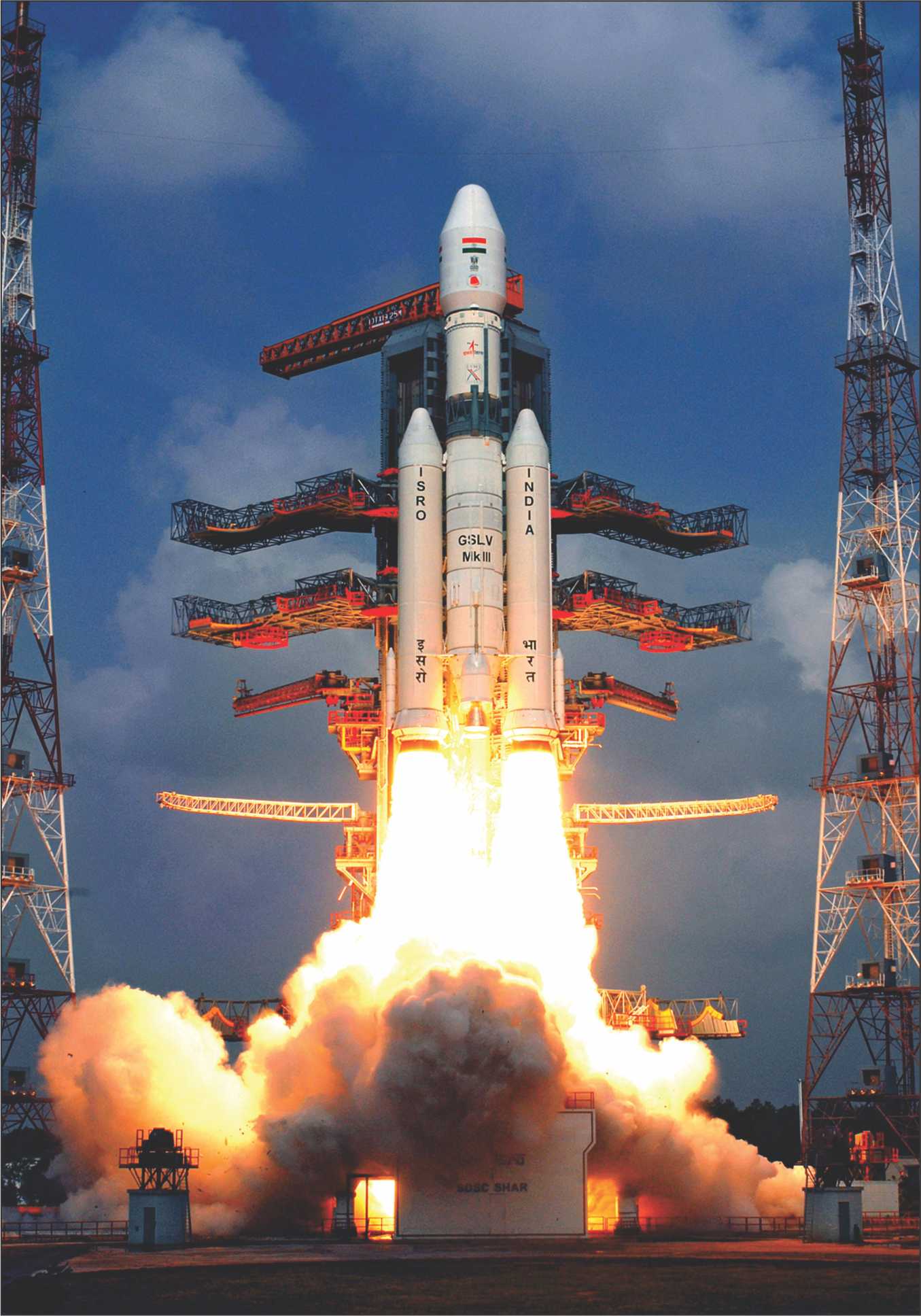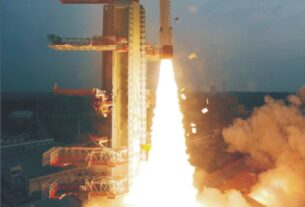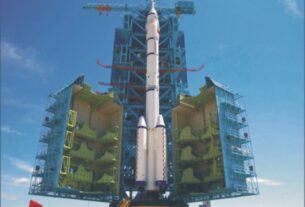In a major thrust upwards for the Indian space program, the three-stage, heavy-weight mark two version of the Geosynchronous Satellite Launch Vehicle (GSLV-MKII) equipped with an Indian made upper cryogenic engine stage scripted a vibrant success story by delivering 2117-kg GSAT-6 communications satellite into its intended orbit with a high degree of accuracy.
This orbital mission of August 27 designated GSLV-D6 has convincingly validated the operational efficiency and structural robustness of the indigenous cryogenic engine stage for the second time. The first successful mission of GSLV-MKII, powered by the domestically built cryogenic engine stage, was accomplished in January 2014. Indeed for the second time ISRO got its cryogenic engine right with GSLV-D6 flight proving the reliability and efficiency of the system. Prior to that, a flight of GSLV-MKII featuring an Indian cryogenic engine stage had ended up in failure in April 2010.
It took GSLV-D6 around seventeen minutes after its smooth lift off from the second launch pad of Satish Dhawan Space Centre (SDSC) in Sriharikota island, located 90-kms to the north of Chennai, to complete its mission. The next GSLV-MKII launch is expected to take place by mid-2016. As envisaged now, Indian Space Research Organisation (ISRO) has set a target of two GSLV-MKII launches per year.
After its operationalization, the 49.1-metre tall, 416-tonne heavy GSLV-MKII will serve as the work horse for launching satellites in 2-2.5-tonne weight category into the geostationary transfer orbit. Consequently, it would free India from its dependence on procured commercial launch service for orbiting its GSAT/INSAT satellites in this weight category at an enormous cost to the national exchequer. Indeed as revealed by sources in ISRO, India had paid something around US$85-90-million as a fee for launching a communications satellite weighing 3.5-tonne. Against such a backdrop, a GSLV mission costs just around Rs 2,200-million. Moreover, an independent heavy lift capability made available by GSLV-MKII and its successor GSLV-MKIII could very well insulate the country from uncertainties that the multi billion dollar global space market could face in the future due to shifting political and geo strategic environment.
Successful mission
In the aftermath of the successful accomplishment of the GSLV-D6 mission, a jubilant AS Kiran Kumar, Chairman of ISRO pointed out that “As a result of tremendous amount of hard work by ISRO team, today’s performance of the launch vehicle clearly demonstrates that all the systems were performing very normally. The intricacies of the cryogenic engine have been understood”. Significantly, a highly motivated team of ISRO scientists and engineers had toiled ceaselessly for about two decades for mastering the complex features of the cryogenic engine technology. Further, around Rs.4000-million was invested for developing the cryogenic engine which makes use of liquid hydrogen and liquid oxygen at extremely low temperatures. The first two stages of GSLV are derived from the modules of the reliable Indian space workhorse PSLV (Polar Satellite Launch Vehicle).
The extremely good performance of the cryogenic engine proven by the two GSLV-MKII missions has spurred ISRO to prepare the ground for the full fledged, maiden flight of heavier GSLV-MKIII launch vehicle by the end of next year. The 630-tonne, three stage GSLV MKIII propelled by a cryogenic engine stage stuffed with 27-tonne of propellant in the form of liquid hydrogen and liquid oxygen is designed to inject a 4-tonne class satellite into a geostationary transfer orbit.
The first two stages of GSLV-MKIII features a two identical solid fuel boosters with 200 tonne solid fuel each while the second stage is a re-startable liquid propulsion system with 110-tonne propellant loading. As it is, recently ISRO had subjected the high thrust cryogenic engine forming part of GSLV-III to ground testing for a duration of 800 seconds at ISRO’s Liquid Propulsion Centre at Mahendragiri in Tamil Nadu.
As envisaged now, GSLV-MKIII is planned to be deployed for realizing the proposed Indian human space flight programme which is yet to receive green signal from the Indian Government. As it is, GSLV-MKIII had its successful experimental, sub orbital flight in last December. This mission carried out with a passive cryogenic engine stage had lofted a prototype of the crew module developed for the Indian manned flight to evaluate its performance during the crucial re- entry stage. This experimental flight had also helped evaluate the dynamics of the ascent of the vehicle during the critical atmospheric phase of the flight.
The significance of GSLV-MKII lies in the fact that it would enable ISRO orbit satellite payloads weighing 2-2.5-tonne into the geostationary transfer orbit at a highly affordable cost “GSLV will cost just one third of the cost we have to spend on foreign agencies,” stated Kumar. He also revealed that once commissioned, the services of GSLV-MKII will be offered on commercial terms for launching the satellite payloads of international customers. Describing GSLV as a good candidate for commercial payloads, Kumar made it clear that “ISRO will have to repeat the launch success of its GSLV-MKII to gain the confidence of satellite owners”.
As it is, Antrix Corporation, the Bangalore based commercial arm of the Indian space programme, has already made modest forays in the multibillion dollar, international market for launching satellites by positioning PSLV as a reliable and cost efficient vehicle for delivering light weight satellite payloads into a variety of orbits. Till now, PSLV has launched 45 satellites belonging to customers from 19 countries on commercial terms. The introduction of GSLV-MKII in the near future followed by GSLV-MKIII thereafter would considerably expand and enhance the scope of the satellite launch service offered by Antrix. Incidentally, a GSLV-MKII rocket will be deployed for orbiting Indo-US spacecraft mission NISAR (NASA-ISRO Synthetic Aperture Radar) in 2021. This microwave earth observation space platform will be particularly useful for studying natural hazards and global environmental changes. On another, front as many as ten Indian satellites have been lined up for launch by means of GSLV MKII in the years ahead. More importantly, GSLV-MKII will be the vehicle of choice for launching India’s second lunar mission Chandrayaan-II during 2017-18 timeframe.
GSLV-MKII is also likely to be used for the deep space planetary missions including the possible follow on mission to Mangalyaan, India’s first ever probe to the Red Planet which created history by being the first ever mission to Mars to enter the orbit around the Red Planet in the very first attempt.
Advanced features
The unique feature of the high power cuboid GSAT-6 satellite, designed for a mission life of nine years, is that it features the first of its kind large unfurlable S-band antenna with a diameter of six metres. This happens to be the largest satellite antenna ever built by ISRO. This antenna would be utilised for five spot beams meant to cover the Indian mainland. The advantageous aspect of spot beams is that they exploit the frequency reuse scheme to increase frequency spectrum utilisation efficiency. The satellite also carries a national beam in C-band for authorised, strategic users. Yet another advanced feature of GSAT-6 isits 70 V bus which is featured for the first time in an Indian communications spacecraft.
In particular, GSAT-6 will provide a platform for developing technologies such as demonstration of large unfurlable antenna in a space platform as well as handheld ground terminals and network management techniques that could be used in future satellite based communications application. What’s more, the inputs provided by GSAT-6 would be a precious asset to design and develop high capacity, futuristic multi media satellites. ISRO is also planning to launch a follow on GSAT-6A satellite with similar features and capabilities.
GSAT-6 is the 25th geostationary communications satellite designed and developed by ISRO. After its commissioning, preceded by in orbit manoeuvres and testing, GSAT-6 will join the group of India’s other operational geostationary satellites. GSAT-6 capability will be used by the Indian defence forces for strategic communications. In particular, armed forces operating in remote, difficult to reach geographical stretches would be able to establish communication links with hand held terminals by making use of GSAT-6 potentials. It will allow Indian defence forces to communicate rapidly and reliably with a view to get a clear, real time picture of the battlefield space. In fact, GSAT-6 also facilitates the two way flow of information including voice, data and video. It will also be harnessed for societal applications including disaster mitigation and emergency response. GSAT-6 will make use of its own on-board propulsion system to reach its final space home at 83 degree east longitude in geostationary orbit.
The technology of cryogenic propulsion is both tricky and challenging, and India happens to be the sixth nation to have mastered the technology of cryogenic engine which is a closely guarded preserve of advanced space faring nations. Cryogenic propulsion system involving the use of propellants at extremely low temperature is capable of delivering a heavier payload into the orbit in comparison to the non- cryogenic rocket fuels. For the specific impulse generated by the cryogenic fuel is much higher than the conventional solid and liquid fuel systems. The biggest technological challenge involved in developing a cryogenic engine system lies in handling oxygen which remains liquid only at a temperature below minus 183 degree Celsius and hydrogen which remains liquid at below minus 253 degree Celsius.
The Indian cryogenic engine stage works on “staged combustion cycle” technique wherein hydrogen is partially burnt with a little oxygen in the gas generator. The hot gases, which drive the fuel booster turbo pumps, are injected at high pressure into the thrust chamber where the rest of oxygen is introduced to facilitate the fuel combustion. Before going to the gas generator, the incredibly chilly liquid hydrogen is used to cool the thrust chamber whose temperature increases abnormally high when the engine is fired.
Interestingly, ISRO had launched experimental studies on cryogenic propulsion system way back in 1980s. The ISRO cryogenic engine team had suggested the development of a 120-kN cryogenic engine for the GSLV with a 10-kN sub-scale engine for data generation to aid evolution of the vehicle design. The first experimental hot test was carried out on a single injector element thrust chamber using gaseous hydrogen and gaseous oxygen for a duration of five seconds in 1987.
But then in late 1980s ISRO deemed it prudent to acquire the cryogenic engine technology from Russia with a view to speed up the development of GSLV. Accordingly in 1991, ISRO signed an agreement with the Glavkosmos space agency of the former Soviet Union for the supply of two flight ready cryogenic engine stages along with the transfer of technology.
But then as the time proven adage goes there is always a slip between the cup and lip. In this case, USA which could not relish the prospect of Indian launch capability posing a threat to the US based commercial launch business, could easily browbeat a truncated Russia-in the aftermath of the disintegration of the Soviet Union-into cancelling its commitment of transferring cryogenic engine technology to India. The argument of USA was that cryogenic engine technology is a dual use system whose transfer is forbidden under the so called Missile Technology Control Regime (MTCR). But then hardly any strategic missile system makes use of cryogenic propulsion.
At the end of the day, the Indo-Soviet agreement was diluted to the supply of seven cryogenic engine stages to enable India sustain the flights of GSLV till such time as an Indian cryogenic engine stage gets ready for operational use. Out of the seven Russian cryogenic stages, six have already been used. And out of the six GSLV flights with the Russian upper cryogenic stage, three ended up in a failure.
Against this backdrop, ISRO launched Cryogenic Upper Stage Project (CUSP) to realize a home grown cryogenic engine stage to boost GSLV. Indeed for ISRO developing a cryogenic engine stage from scratch was a really tough and challenging exercise as it involved the mastery of materials technology, operation of turbo pumps at an extremely high speed and tackling the challenges associated with handling the highly volatile liquid oxygen and liquid hydrogen.
Enhancing capability
With a view to boost the lift off capability of its existing launch vehicles, ISRO is now on the job of developing a semi cryogenic engine stage which uses kerosene as a fuel and liquid oxygen as an oxidiser ISRO has covered much ground in the development of the semi cryogenic engine capable of generating a thrust of 2000-kN. A number of tests to qualify various systems and sub-systems of semi cryogenic engine stage have already been carried out. It is expected to be ready by 2017. By replacing the core stage of the existing vehicles with semi cryogenic engine stage, it would be possible to substantially enhance the payload carrying capability of the vehicle in a very cost effective manner. Such unified launch vehicles are considered ideal for deep space probes including the sample return mission to moon. Further, the high performance semi cryogenic engine stage could form a part of the reusable space vehicle that ISRO is now developing.
Looking beyond the conventional space launch systems, ISRO is now developing a reusable space vehicle with a view to reduce the cost of accessing space and also to make space missions a routine exercise. One of the key elements of the Indian reusable space vehicle would be an air breathing propulsion system. In distinct contrast to the conventional space launch systems based on the burning of the propellant with the help of oxygen as oxidiser, an air breathing propulsion system is designed to carry only the fuel in the form of hydrogen sans oxidiser. The on-board hydrogen is burnt to generate thrust through the mechanism of sucking atmospheric oxygen for combustion. This makes for a substantial enhancement in payload carrying capability along with the overall reduction in cost. Since air breathing propulsion system has the capability to operate only during the atmospheric phase of the flight, it always needs to be adopted along with a conventional rocket booster stage to meet the final orbital requirements.
The first technology demonstration flight, to prove the concept of Indian reusable space vehicle, is planned to take place sometime this year. This mission will be launched from Satish Dhawan Space Centre (SDSC), the Indian spaceport on Sriharikota island in the Bay of Bengal. The test vehicle for this flight would fly at five times the speed of sound to touch an altitude of 100-kms. After activating its tail and fin control system, the vehicle would glide a bit before starting its descent to land in the Bay of Bengal.
For this flight ISRO has developed heat resistant tiles that would form the outer cover of the test vehicle that would be subjected to high atmospheric temperature. These would be able to withstand extremes of temperature of upto 1,200 degree Celsius that the US space shuttle used to experience while re-entering the earth’s atmosphere. ISRO has also configured a winged Reusable Launch Vehicle Technology (RLV-TD) vehicle to serve as a flying test bed to evaluate various technologies including hypersonic flight, autonomous landing, powered cruise flight and hypersonic flight using an air breathing propulsion system towards realizing a two stage to orbit (TSTO) full fledged reusable space vehicle featuring futuristic technologies.





